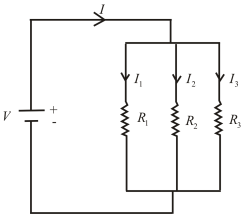
(a)
The current passing through a parallel circuit.
(a)
Answer to Problem 22E
Explanation of Solution
Given info: First resistor having resistance
Explanation:
In a parallel circuit two resistors are arranged with their heads connected to head and tails are connected tails across the dc voltage source as shown in below figure.

Formula to calculate the equivalent resistance in a parallel circuit is,
Here,
Substitute
The current passing through a parallel circuit is divided among each resistor.
The expression for current passing through each resistor is,
Here,
Write the expression for current in terms of voltage and resistance in a parallel circuit.
Here,
Substitute
Substitute
Further, solve the equation.
Conclusion:
Therefore, the current passing through the resistors in a parallel circuit is
(b)
The power expended in the parallel circuit.
(b)
Answer to Problem 22E
Explanation of Solution
Given info: First resistor having resistance
Explanation:
The expression for power in terms of voltage and resistance is,
Substitute
Conclusion:
Therefore, the power expended in the parallel circuit is
Want to see more full solutions like this?
Chapter 8 Solutions
Bundle: An Introduction to Physical Science, 14th Loose-leaf Version + WebAssign Printed Access Card, Single Term. Shipman/Wilson/Higgins/Torres
 Principles of Physics: A Calculus-Based TextPhysicsISBN:9781133104261Author:Raymond A. Serway, John W. JewettPublisher:Cengage Learning
Principles of Physics: A Calculus-Based TextPhysicsISBN:9781133104261Author:Raymond A. Serway, John W. JewettPublisher:Cengage Learning Glencoe Physics: Principles and Problems, Student...PhysicsISBN:9780078807213Author:Paul W. ZitzewitzPublisher:Glencoe/McGraw-Hill
Glencoe Physics: Principles and Problems, Student...PhysicsISBN:9780078807213Author:Paul W. ZitzewitzPublisher:Glencoe/McGraw-Hill
 Physics for Scientists and Engineers, Technology ...PhysicsISBN:9781305116399Author:Raymond A. Serway, John W. JewettPublisher:Cengage Learning
Physics for Scientists and Engineers, Technology ...PhysicsISBN:9781305116399Author:Raymond A. Serway, John W. JewettPublisher:Cengage Learning College PhysicsPhysicsISBN:9781938168000Author:Paul Peter Urone, Roger HinrichsPublisher:OpenStax College
College PhysicsPhysicsISBN:9781938168000Author:Paul Peter Urone, Roger HinrichsPublisher:OpenStax College Physics for Scientists and Engineers: Foundations...PhysicsISBN:9781133939146Author:Katz, Debora M.Publisher:Cengage Learning
Physics for Scientists and Engineers: Foundations...PhysicsISBN:9781133939146Author:Katz, Debora M.Publisher:Cengage Learning





